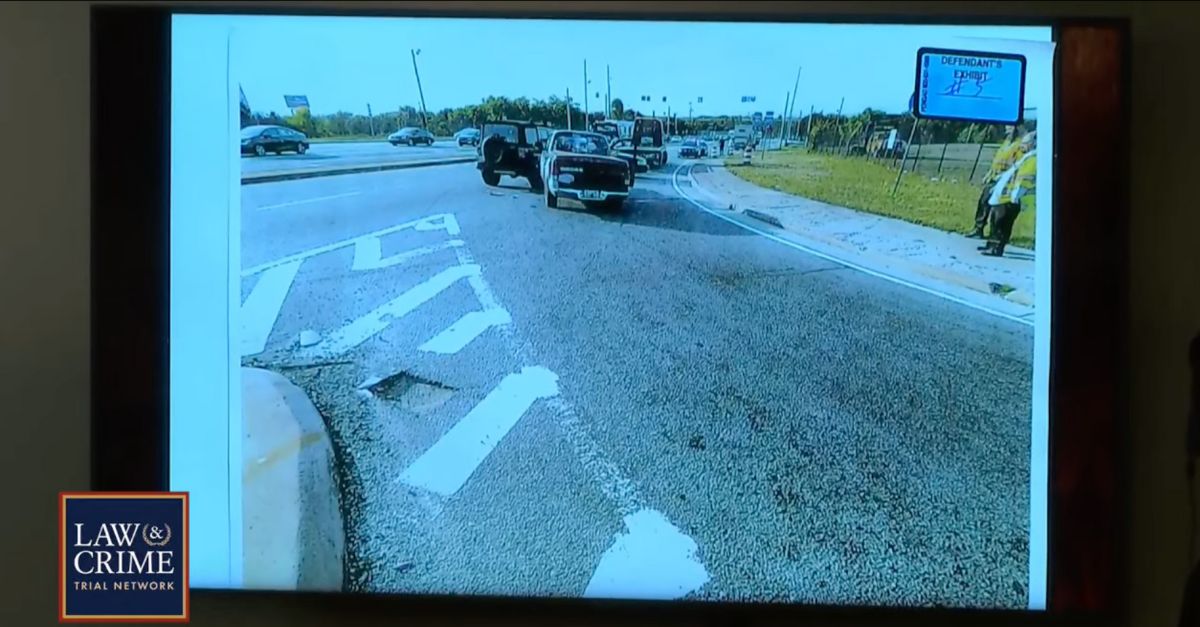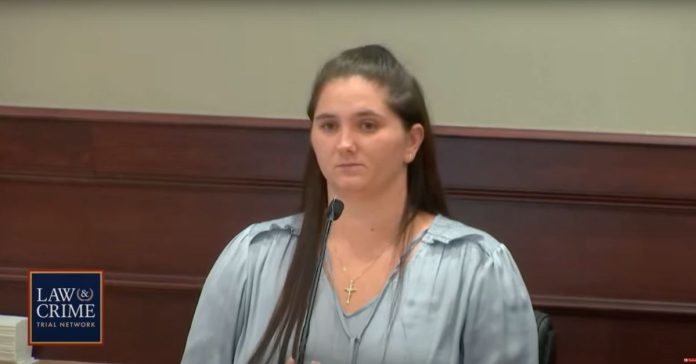A woman facing multiple charges for allegedly shooting and killing a man during a failed citizen’s arrest took the stand on her own behalf in Clayton County, Georgia, late Monday afternoon.
Hannah Payne, 24, admittedly never drew her weapon before the day of the traffic accident that changed her life and ended in another person, Kenneth Herring, 62, losing his time on earth forever.
“The way you hold it is based on what you’re ready to do,” the defendant said in court before her judge and jury, recalling a firearms self-defense course she once took that focused on gun storage.
Payne insisted that she never meant for her brandished handgun to ever fire a bullet on that fateful day in May 2019. Rather, she said, the deceased man shot himself.
Earlier in the day, the judge pressed and prodded Payne on the decision to testify — and its potential implications on her case.
“Do you personally want to testify or not?” the judge asked.
“Yes, ma’am,” the defendant said.
“Meaning what?” the judge clarified.
“I want to testify,” the defendant said, before audibly and loudly breaking down and crying. Several minutes later, she took the stand.

Hannah Payne testifies in court during her murder trial in Clayton County, Georgia on Dec. 22, 2023. (Law&Crime Network)
The defendant faces two counts of felony murder, three counts of possession of a weapon during a crime, and a count each of malice murder, aggravated assault, and false imprisonment.
Authorities have said Herring drove through a red light in his Dodge Dakota pickup truck, causing a minor crash with a semi-truck. Testimony at an earlier hearing suggested that Herring stayed at the scene of the crash for roughly 15 to 20 minutes.
A witness — a state corrections officer with medic training — saw the crash, and came up to speak to Herring, a detective previously testified. Based on his training, the witness suggested Herring was having a medical emergency — a diabetic shock or something of that nature. For example, Herring was disoriented, displayed red-orange eyes, and had walked around his truck several times.
Payne was on her way home from her job in property management when she also witnessed the traffic accident, she testified.
The light was green for herself and the semi-truck driver, the defendant testified. She pulled off to the side of the road and then called 911 to explain what she saw, Payne told the court. She even went over to the semi-truck driver to confirm Herring was at fault.
Payne said that at various points, she was talking with the truck driver, the truck driver’s employer via his in-truck dispatch radio, and the 911 dispatcher to share information about the accident — principally about the alleged red-light runner being at fault.
“We were kind of just standing there waiting for the police to arrive,” Payne testified.
At one point, the other witness flashed a badge on his breast and identified himself as a “state officer,” the defendant said. Payne did not know the other witness was only a correctional officer “until months later” when informed by her attorney, she testified.
The defendant went on to say the officer “was kinda hyped up” and seemed like “he wanted to make sure he was in charge in a way.”
“He’s OK but he’s definitely inebriated,” the officer allegedly said at one point, Payne testified. This alleged claim prompted her and the semi-truck driver to ask at the same time: “Do you mean he’s drunk?”
At least 10 minutes later, Herring got out of his truck and started walking around, the defendant said. At first, the state officer was calm and it appeared to her that he was trying to make sure Herring, who she believed was inebriated, was safe, Payne testified.
Then, the state officer gave the impression that “something was up” with the red-light runner but she didn’t know what, she said.
Payne then walked back to her vehicle to call her family. At the same time, she noticed what she described as an increase in tension between the red-light runner and the state officer. So, she decided to hang up and call 911 for the second time, the defendant testified.
Herring indeed drove off after the witness advised him to sit back in his truck, as previous testimony in the trial has established.
The next few moments are contested.
“Go, go go!” the state officer allegedly shouted at Payne — instructing her to pursue Herring, she said. Payne, on the line with 911, admittedly followed Herring in her car and caught up with him at an intersection. Authorities allege Payne blocked Herring in with her Jeep even though the 911 operator told her to stay away because it was safer.
The defendant says that the last part is wrong — testifying on Monday that Herring either willingly paused in the turning lane or that his badly damaged truck had simply and finally gone out of service.

An image of Kenneth Herring’s truck and Hannah Payne’s Jeep from behind. (Law&Crime Network)
The way Herring’s truck was stopped became a sharp point of contention on cross-examination. A prosecutor showed the court two images from two vantage points of Payne’s Jeep stopped in front of Herring’s truck — the right side of the defendant’s vehicle partially in Herring’s lane, Payne’s passenger-side tire veering to the right.

An image of Kenneth Herring’s truck and Hannah Payne’s Jeep from in front. (Law&Crime Network)
“I saw him stopped in the turning lane, so I turned as well,” Payne testified. “When I stopped, I was under the impression, with having 911 on the phone, that I could be a messenger.”
Payne said she initially only intended to get the driver’s license plate information, which she said the 911 dispatcher had asked of her.
The state claims the audio from the 911 call shows the dispatcher was adamant that Payne not pursue Herring. The audio is also clear the defendant was adamant she was going to go after him.
“He is drunk. I’m not,” Payne told the dispatcher before the fatal confrontation. “I’m sorry, but I’m here to tell you I’m not not going to follow him because he is going to cause an accident.”
During cross-examination, a prosecutor said the 911 operator told the defendant roughly four times to go back to the scene and not to chase Herring. Payne contested that, however, saying she only heard the explicit command not to chase Herring one time. The defendant also said she understood the dispatcher to mean that the police wanted both her and Herring to return to the original accident site.
According to her testimony on Monday, Payne’s “interpretation” was that going after Herring was “what she wanted me to do.”
Once both vehicles had stopped, Payne got out of her Jeep. Then, palming the phone, with the dispatcher on speaker, she held it out to Herring with the screen forward for him to see that 911 was on the other line, she testified. When asked by her attorney to clarify, the defendant she did not use her Jeep to make contact with the truck.
“I was walking up to him and I am explaining that I’m on the phone with the police and that they wanted us to go back to the original accident site,” Payne testified on direct examination. “It’s loud. We’re near an interstate. And it’s a busy road. And I can’t hear what he’s saying to me. But as I got closer, I heard him asking me: ‘Who the F are you?’ and I told him that I was nobody but I that I had the police on the phone and that they wanted us to go back to the original accident site.”
Then, Payne said, Herring reached out of his truck and grabbed her.
“He knocked my phone out of my hand and he grabbed me by my wrist and he pulled me into the vehicle,” the defendant testified, occasionally pausing with emotion. “He pulled me in the car, and at some point my shirt had gotten grabbed, and he was pulling my wrist and he pulled me in the vehicle and he kept yelling at me. Telling me: ‘I have something for you.’ And he used — ‘I have some.’ Pardon: ‘I have something for you, bitch.’ And he’s reaching and he’s pulling. And at this point, I remember that — I’m I’m sorry — I remember that he let go of my wrist and he had grabbed me by the back of my neck.”
Payne testified Herring “mashed the gas” and the truck started to lurch forward — with her body partially dangling out of the side.
“While it only may have been a few steps or a few feet, when you are being held against your will and you have no idea what’s ahead of you and you’re looking down, it feels like it lasted forever,” she said.
Payne said she never stopped trying to pull away from Herring and eventually announced that she had a gun to try and get her alleged assailant to let her go. Then the gun came off the hip holster.
“I pulled it out and immediately started trying to just continue to push against the door with it — like push it away from him” she testified. Then, she said: “He grabbed my hand with the gun in it.”
The defendant said Herring started trying to yank the gun away from her with both his hands. She described this effort as something that felt like a combination of pushing and prying on her right hand.
During a demonstration with a toy gun, Payne and her defense team put forth a version of events where the struggle for the gun resulted in one of Herring’s four right-hand fingers to fall onto the trigger.
All the while, the defendant said, she screamed for Herring to stop.
“As he’s pulling it is when it — the trigger went off,” she said. “After it went off, my entire body kind of fell backwards.”
While the 911 call did not pick up Payne screaming repeatedly at Herring, a bystander’s cellular phone video caught the tail end of the struggle between the two and jurors heard audio that Payne did scream at him.
In response to a question from her attorney, Payne said she had “no idea” the events of that day would end the way they did.
Asked by her attorney what she “took away from all this” some four-and-a-half years later, the defendant appeared to tear up.
Wearing a light blue shirt with a large, gold-colored cross on a gold-colored chain plunging into her neckline, Payne cleared her sinuses and said: “Clearly trying to do the right thing is not the right answer.” She added that she would never try to help anybody ever again.
The defendant — throughout the direct examination, cross-examination, and redirect from her own attorney — readily said there were several ways the events of May 7, 2019, “could have just been avoided.”
On the state’s re-cross-examination, the prosecutor sought to establish that the primary way the loss of life could have been avoided was if the defendant had not “introduced a gun into this incident”
“I introduced the gun to try and save my life,” Payne replied.
Have a tip we should know? [email protected]

